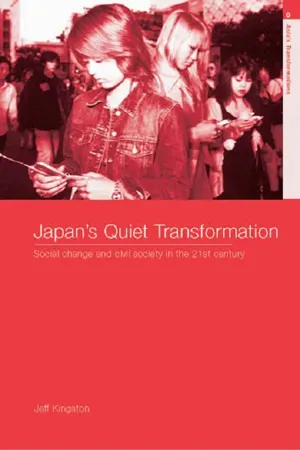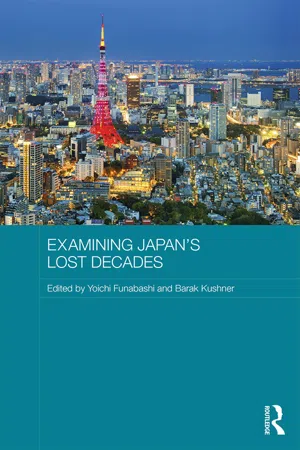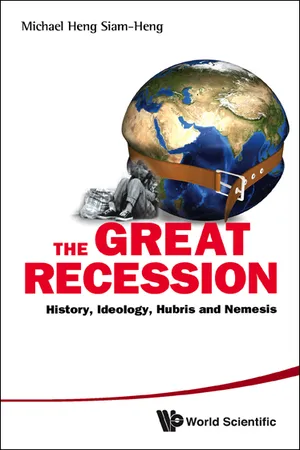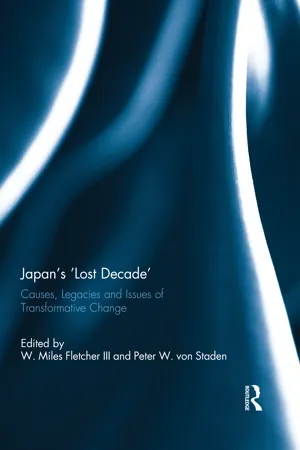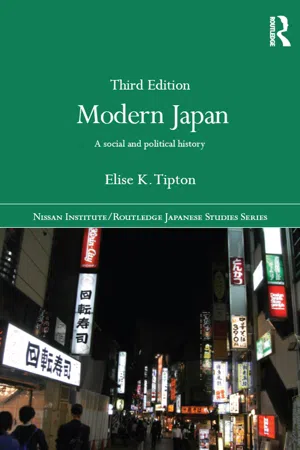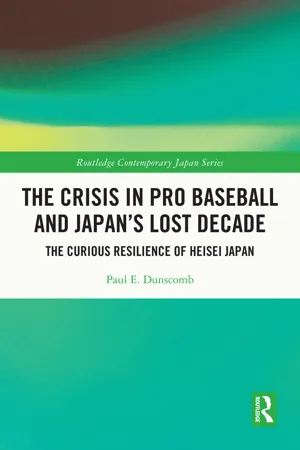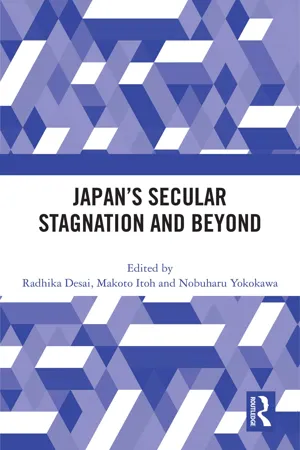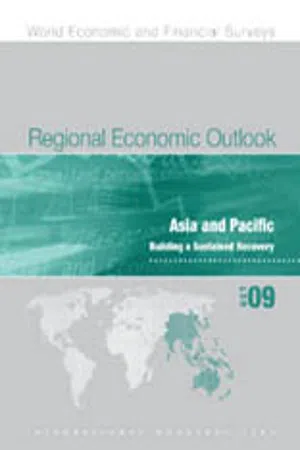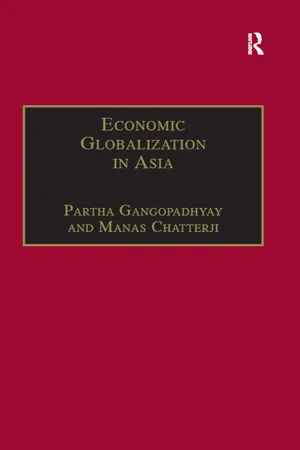Economics
Japan Lost Decades
The "Japan Lost Decades" refers to the period of economic stagnation that Japan experienced following the collapse of its asset price bubble in the early 1990s. This era was characterized by low economic growth, deflation, and a struggling banking sector. The government implemented various stimulus measures and monetary policies to try to revive the economy, but the effects were limited, leading to a prolonged period of economic malaise.
Written by Perlego with AI-assistance
Related key terms
12 Key excerpts on "Japan Lost Decades"
- 4Lost Decades and DisastersThe story of Japan’s Lost Decades began in the early 1990s, but the economic malaise persisted into the twenty-first century. Prime Minister Abe Shinzo promoted Abenomics to end that stagnation, and there are positive signs of progress in doing so, but after many false dawns over the years and the dilemmas posed by a shrinking and aging population, the public remains skeptical.The collapse of the late 1980s asset bubble precipitated the Lost Decades, as stock and land prices imploded by over 60 percent, burying banks under bad loans and forcing investors into staggering losses. The exuberance and hubris of the 1980s gave way to gathering anxieties that extended beyond the state of the economy. Two major events in 1995 – the Kobe earthquake and a terrorist attack by Aum Shinrikyo, a religious cult – reinforced public perceptions that the government was ineffectual, generating a sense of crisis and despair about a system that was no longer capable of dealing with the challenges confronting Japan. This vanishing confidence also drew on a series of scandals implicating the mandarins and politicians who were the guardians of the Japan, Inc., post-WWII model; they and that system lost credibility. These changing perceptions and ebbing support for a system that had worked quite well for four decades is propelling Japan’s slow-motion third transformation; it is so gradual and incremental there are reasons to doubt it is even happening. Yet, the ways and means of that model are now questioned. A frustrated public is no longer as deferential, and desperate for those in charge to offer a vision of hope and get on with the job.People understand that the bureaucrats who guided the economic miracle made a series of mistakes that led to the Lost Decades and also in dealing with the consequences. This was exacerbated by a fusty corporate culture, where complacency and inertia trumped a sense of urgency. People also better understand the limits of employer paternalism and to what extent a succession of political leaders have failed the test of leadership, perhaps with the exception of Prime Minister Koizumi Junichiro (2001–6) and the reincarnated Abe who disappointed in his first spell as prime minister in 2006–7, but has been more resolute since returning to power in 2012.
- eBook - ePub
Japan's Quiet Transformation
Social Change and Civil Society in 21st Century Japan
- Jeff Kingston(Author)
- 2004(Publication Date)
- Routledge(Publisher)
1 The Lost Decade ofthe 1990sThe so-called Lost Decade of the 1990s has been misunderstood because it really marks a watershed in Japan and has been a time of far reaching transformation. Gerald Curtis, Professor of Political Science, Columbia University, July 26, 2002During the Lost Decade the powerful and privileged lost while ordinary people benefited.Miyazaki Ikuko, founder of Mail Magazine , an internet job information service for working women, August 2002The final ten years of the twentieth century have been called a ‘lost decade’ for Japan, which continues to suffer woes from the burst of the late-1980s bubble economy. Japan's comeback as a globally competitive economic powerhouse will require fundamental reforms not only in the industrial and financial sectors but also in government administration, politics and social systems, including education, the judiciary and immigration.Japan Times , January 1, 2001The 1990s in Japan have been dubbed the Lost Decade. This is a period when the economy imploded, the asset bubble collapsed, banks teetered on the edge of insolvency, unemployment skyrocketed, suicides increased and the leaders of Japan, Inc. were tarnished by exposés of pervasive corruption. The nation of the ‘economic miracle’ found itself looking into the abyss, lunging from the swaggering late 1980s, when commentators gushed about a Pax Nipponica, to the sobering realities of the turn of the century when analysts predicted systemic collapse. The nation's credit rating slumped to the level of junk bonds and zombie companies staggered towards bankruptcy. Everything seemed to go wrong at the same time, an inauspicious beginning to the Heisei era, a period that has virtually become synonymous with Japan's prolonged recession.1What was lost in the Lost Decade? Mountains of money, a sense of security, stable families, and the credibility of the nation's leadership. To this standard list of debits one might add hubris and confidence about the future. The mighty have been brought low and the reputations of some have been dragged through the mud. Many topics that were once carefully avoided have now been brought into the open: subjects such as money politics, mob influence, and pervasive malfeasance are now regularly aired in a feistier national press. Also lost in the 1990s was an orchestrated innocence about the nation's shared past with Asia between 1931 and 1945. - eBook - ePub
- Yoichi Funabashi, Barak Kushner, Yoichi Funabashi, Barak Kushner(Authors)
- 2015(Publication Date)
- Routledge(Publisher)
3 The two “lost decades” and macroeconomics Changing economic policies Kobayashi Keiichiro DOI: 10.4324/9781315715223-3Introduction
The expression “lost decades” is nowadays used to refer to the economic and market decline and broad political and social conditions in Japan in the last decade of the twentieth and the first decade of the twenty-first century. As Andrew Gordon points out in Chapter 5 , the term gained currency in the media, first foreign, then Japanese, in the second half of the 1990s. At the time, the phrase was used to refer to the long-term decline in Japan’s growth rate that had started at the beginning of the 1990s, in contrast to the remarkable economic growth shown in the decades after World War II, especially from the 1960s onwards.Japan’s growth rate plummeted in the 1990s, and it remained low in the early years of the twenty-first century. In terms of GDP growth, it is indeed appropriate to say that these two decades were lost. However, the demographic shifts that Seike Atsushi discusses in Chapter 1 , including the population decline and changes in the working-age population since 1995, give rise to a slightly different picture. As Figure 3.1 shows, during the 2000s the working-age population’s per capita GDP growth rate in Japan actually outshone that of the United States. It may not be so simple therefore to describe the past twenty years as completely “lost.” The evidence suggests that the situation is slightly more nuanced, and varying opinions among economists demonstrate something far from a consensus.This chapter adds an additional perspective to the study of the lost decades. It does so in two ways: first by investigating the macroeconomic policies that were taken at the time and second by elucidating the opportunities that were gained and lost during the two lost decades. In this way, lessons can be learned for present-day Japan and advanced Western countries. - eBook - ePub
Great Recession, The: History, Ideology, Hubris And Nemesis
History, Ideology, Hubris and Nemesis
- Michael Siam-Heng Heng(Author)
- 2010(Publication Date)
- WSPC(Publisher)
Chapter FourInsights from Japan’s “Lost Decade”a
Introduction
In retrospect, the most dramatic turning point in the half-century of Japan’s postwar economic development was the collapse of the property and stock market in 1990. The collapse ushered in a very long period of recession known as the “lost decade”.1 Japanese economy experienced average annual real growth of 0.8% from 1991 to 2001.2 One would expect that with fiscal stimuli, the economy would recover as in a normal business cycle. But somehow the recovery simply refused to show up. Conventional wisdom of economic stimulation does not tally with the Japanese experience of the long recession. The “lost decade” has acquired such an iconic status that economists and business columnists have evoked it as a possible prospect of the current recession for the USA.3Indeed, as the second largest economy in the world and operating in an electoral democratic framework, its experiences may shed some light on the nature of recession of an advanced industrial economy in the context of globalization, as well as the limitations of monetary and fiscal stimuli to deal with such a recession.There are three reasons for us to study Japan’s experiences for insights. First, America’s and the UK’s troubles are in some deep sense similar to Japan’s. They are a result of a real estate bubble and easy credit. The prices of resident property in 10 largest cities of the USA doubled in five years, just like those prices in Japan’s big cities during the bubble period.4 What is more disturbing is that nationwide, prices of resident units, and commercial property in the US and the UK shot up more than they did in Japan. It is also relevant for Asia because a property bubble preceded the 1997 crisis. Second, Japan shares the essential features of an advanced industrial economy with Western Europe and the USA. The “lost decade” is likely to hold lessons for them. Third, the Japanese trajectory of economic development has offered very useful concepts for other Asian countries to emulate. This pattern is captured metaphorically in the “Flying Geese” model.5 - eBook - ePub
Japan's 'Lost Decade'
Causes, Legacies and Issues of Transformative Change
- W. Miles Fletcher III, Peter W. von Staden(Authors)
- 2014(Publication Date)
- Routledge(Publisher)
Dreams of economic transformation and the reality of economic crisis in Japan: Keidanren in the era of the 'bubble' and the onset of the 'lost decade,' from the mid-1980s to the mid-1990sW. Miles Fletcher III Department of History, C.B. 3195, Hamilton Hall, University of North Carolina, Chapel Hill, NC 27599-3195. USAThis study examines the dynamics of the development of Japan's notorious 'lost decade' from 1990-2003. This economic downturn marked the end of four decades of strong economic growth and is still affecting the Japanese economy today. While previous studies have focused on government policies to explain the nation's slow response to this crisis, the attitudes of the Japanese business community merit more attention. For example, the leaders of Keidanren. the powerful representative of big business in Japan, defined a set of economic challenges facing Japan in the late 1980s and neoliberal solutions that blinded them to the significance of the economic bubble that developed at that time and its subsequent collapse. Since then. Keidanren's prescriptions for reviving the Japanese economy have remained essentially the same.Introduction
The economic stagnation that Japan experienced between 1990-2003, what the Japanese have dubbed as the lost decade, marked the end of four decades of impressive economic growth. After nearly 15 years of rapid growth starting in the late 1950s, the economy had weathered the oil crisis of 1973-1974 to resume a more moderate but still steady pace of expansion. The nation's economic prowess prompted scholars to search for the reasons for this success (Vogel 1979, Johnson 1982). Now, studies often focus instead on the causes and effects of the economic crisis that gripped Japan during the 1990s, commonly known as the lost decade (Katz 1998, Grimes 2001, Lincoln 2001, Amyx 2004, Beason and Patterson 2004, Rosenbluth and Thies 2010). - eBook - ePub
Financial Crisis, Contagion, and Containment
From Asia to Argentina
- Padma Desai(Author)
- 2014(Publication Date)
- Princeton University Press(Publisher)
4 Japan: The Lost Decade of the Nineties amidst Policy Paralysis T HE J APANESE ECONOMY’S prolonged decline in the nineties turned into a recession toward the end of 2000 marked by mounting price deflation. During this period, attempts to revive the economy via fiscal pump priming led to resource misuse into pork barrel projects. Monetary easing failed to stimulate consumer demand by households or capital spending by industry. A softening of the yen in late 2001 calculated to boost exports raised protests from Asian neighbors and the U.S. treasury. The prolonged policy paralysis, which I analyze in this chapter, arose from the leadership’s failure to enforce a cleanup of banks that were burdened by massive nonperforming loans and free Japanese industry from widespread regulations and high taxes. The economy’s decline also affected Japan’s traditional role as an active investor and lender in the small Asian economies and affected their export sectors as the Japanese recession coincided with that of the U.S. after 9/11. The Mounting Economic Malaise In the late eighties, propelled by expansionary fiscal and easy monetary stimuli, Japan turned into a bubble economy of unparalleled asset price inflation especially in urban land values that rose sevenfold in less than a decade, in turn providing collateral against bank lending to companies that dizzily invested in real estate and urban property. The keiretsu, “happy-family” links between banks and industry groups marked by cross-shareholdings and low-margin corporate lending by banks, misallocated capital in dubious projects financed by bank loans to the tune of 12 percent of gross domestic product (GDP) when asset prices collapsed from their 1990 peak. Property prices continued tumbling for the ninth year in a row in 1999 forcing sales of some urban commercial properties at 80 percent or more below their peak values - eBook - ePub
Modern Japan
A Social and Political History
- Elise Tipton(Author)
- 2017(Publication Date)
- Routledge(Publisher)
12 The ‘lost decade(s)’The collapse of the bubble economy in the early 1990s ushered in more than one ‘lost decade’ of economic growth, and it contributed to a wide sense of social and political malaise by the beginning of the new millennium. Far from the new century being a ‘Japanese century’, some foreign commentators now characterized Japan as a ‘setting sun’, as opposed to a ‘rising sun’. To some Japanese observers as well, many of the institutions, structures and values that fostered Japan’s economic growth and social stability in the past came to be seen as obstacles to growth. Recurrent recessions, ‘restructuring’ and high unemployment rates shredded postwar Japan’s social contract – economic prosperity for all in return for hard work and loyalty. Instead, they created insecurity and new troubled social groups of once privileged middle-class salarymen and university graduates, while social issues of ageing, minority discrimination, women’s inequality and problems of children and teenagers remained unresolved. Dashed was the myth of most Japanese as middle class, replaced by a sense of an unequal society (kakusa shakai). The mass media, popular culture and consumer industries were often blamed for spreading materialist values and encouraging violence and decadence. We will see that they also offered some new role models and lifestyle choices and pride in Japan’s ‘soft power’ throughout the world.In contrast to the years of miracle growth, the government, including both politicians and bureaucrats, seemed too mired in corruption and conservative values to lead the country out of the economic slump. Moreover, political confusion and unstable leadership set in with the collapse of the ‘1955 system’ in 1993. The need for structural reform of politics and the economy was voiced everywhere, but little progress was made in practice. As a leading newspaper editorialized during the lead-up to the first general election of the twenty-first century, ‘the 1990s is often referred to as a “lost decade.” Much of the blame for this lost time falls on political parties for their inability to fulfill their primary obligations’.1 - eBook - ePub
The Crisis in Pro Baseball and Japan's Lost Decade
The Curious Resilience of Heisei Japan
- Paul Dunscomb(Author)
- 2023(Publication Date)
- Routledge(Publisher)
2 Lost Decades Troubles for Japan and NPB, 1992–2003DOI: 10.4324/9781003415510-3How many of the three decades of the Heisei period were actually lost? It depends on what you measure. The phrase was first associated with the flat economic growth of the 1990s, but even that initial lost decade always referred to something more. Japan's economy was never flat in the 1990s; it grew and it shrank in response to various crises and attempts at revitalization. But the crises that beset Japan shortly after the start of the Heisei period were never solely economic; they were political and social, diplomatic and security related, and they touched on fears that the world Japanese had come to know, and in many cases had come to count on for their sense of themselves, was dissolving. What ultimately proved the first half of the Heisei era turned out to be a period of transition and adjustment, unique unto itself. For this reason, there is truly only one Lost Decade in the history of Heisei Japan, and it began in 1992.Perhaps the most striking thing about Lost Decade Japan was that at least through 2003 things only seemed to get worse and worse, and the mood of public pessimism and sense of inescapable decline hardened into paralyzing passivity and resignation.1 Yet, somehow, the worst-case scenario was avoided. Japan did not lapse into an economic free fall. Its banks, insurance companies and pension systems did not implode. Japanese society steadfastly declined to collapse into anarchy, and the Lost Decade eventually came to an end. This happened so quietly, and perhaps unexpectedly, that it proved difficult to notice at the time.These years proved an equally difficult time for Nippon Professional Baseball (NPB). The summer of 2004 would be the culmination of a series of crises that had plagued the sport and threatened its very structure. Just as Japanese baseball is distinctive in the way one practices, plays and watches the game, how Japanese baseball as a business operated was decidedly different from Major League Baseball (MLB) in the United States. Many key elements of that distinctiveness (the parent company/franchise relationship and the “content provision” role of the ball club for instance) had been around from the start. But NPB achieved its mature form at the same time as Japan's postwar political economy. Especially in its capacity to tolerate structural inefficiencies (such as “red ink management” and “donburi accounting” practices) it mirrored both the strengths and weaknesses of that system. And just as Japan's postwar political economy began to come under severe stress as the Heisei period began, the basic operating model for NPB also proved increasingly difficult to sustain. NPB and Japan suffered parallel Lost Decades. - eBook - ePub
Too Much Stuff
Capitalism in Crisis
- Yamamura, Kozo(Authors)
- 2017(Publication Date)
- Policy Press(Publisher)
EIGHTJapan: bubbles, “lost years” and Abenomics
Introduction
The Japanese economy entered its “bubble” years in the late 1980s, but the bubble burst in 1991, ushering in a period of economic stagnation that continues today. The economic policies adopted since 1991 have been pro-investment policies that are ineffective in the new world. The incompetent conservative and center-left governments of the 2009–12 period prolonged the stagnation, and since 2013 the government of the conservative Liberal Democratic Party has been pursuing a delusional variant of pro-investment policies. This chapter first discusses the bubble years and the period to 2008, and then the period from 2009 to the present.The bubble and the “lost” years, 1980–2008
At the beginning of the 1980s, Japan was flying high. The economy was growing at almost 4 percent per year and many people in Japan and the West were touting Japanese economic institutions and practices as models the West should emulate. During the second half of the 1980s, the prices of stock and land both soared, the Japanese travelled abroad in unprecedented numbers and foreign investment by Japanese companies increased very rapidly. For example, Japanese FDI (foreign direct investment that does not include investments in stocks and bonds) in the US surged from $2 billion in 1985 to $20 billion in 1990.The reason for the soaring prices of land and stocks during the second half of the 1980s was the Plaza Accord of 1985. This was an agreement among the US, Japan, West Germany, the UK and France to depreciate the dollar against the yen and the German mark. The request for the agreement came from the US, where industries were facing a significant competitive disadvantage because the value of the dollar had risen so strongly, especially against both the yen and the mark. Japan’s central motivation in agreeing to the terms of the Accord was to minimize trade friction with the US, its most important customer. Also, the US was providing a “nuclear umbrella” under a bilateral mutual security treaty that enabled Japan to spend only 1 percent of its GDP on national defense, while Germany was spending about 3 percent and the US close to 6 percent of GDP on defense. - eBook - ePub
- Radhika Desai, Makoto Itoh, Nobuharu Yokokawa, Radhika Desai, Makoto Itoh, Nobuharu Yokokawa(Authors)
- 2023(Publication Date)
- Routledge(Publisher)
To be sure, Japan remains a prosperous society and its growth record over the past thirty years and more is not quite as dismal as much of the literature on its ‘lost decades’ and ‘secular stagnation’ might suggest. Over the past three decades, at least two ‘booms’ have livened the otherwise gloomy Japanese outlook, the Izanami boom of the 2000s and the Abenomics boom of the 2010s (Hayakawa 2020). As The Economist recently noted, ‘Overall growth has remained sluggish, but growth per head has recently been comparable with others in the G7. Unemployment has been minimal, longevity has increased and inequality has stayed relatively low.’ Moreover, the same Economist report quoted a 2020 tweet by Paul Krugman that pointed to another reality. Within a decade of Japan’s slowdown, other major advanced economies, including the US after its ‘roaring nineties’, had entered a period of low growth which appears similarly intractable. Krugman had tweeted, ‘Maybe Western economists who were so critical of Japan circa 2000, myself included, should go to Tokyo and apologize to the emperor. Not that they did great; but we did much worse.’ (The Economist 2021). Of course, since neoliberalism never reversed the Long Downturn, the neoliberal decades were, in any case, decades of markedly lower growth than experienced in the advanced capitalist world during the ‘golden age’ or Long Boom. What was novel was that bubble driven growth had ended even in the US and was proving intractable to the most strenuous exertions authorities were willing (as quite distinct from able) to make. So low growth could no longer be dismissed as a peculiar Japanese malady or ‘Eurosclerosis’. As intractable low growth pervading all advanced economies is acknowledged, its causes, consequences and significance need to be understood and growing literature seeks to do so. However, the syndrome of low growth raises fundamental questions about the viability and desirability of capitalism - eBook - ePub
- International Monetary Fund. Asia and Pacific Dept(Author)
- 2009(Publication Date)
- INTERNATIONAL MONETARY FUND(Publisher)
During the spring, when the crisis was turning global, the May 2009 Asia and Pacific Regional Economic Outlook looked back at the lost decade in search of lessons for combating the outbreak and containing its fallout. With conditions now having stabilized, this chapter revisits Japan’s history for insights on the process of economic recovery, highlighting two episodes in which green shoots emerged but could not be sustained. Based on Japan’s experience, the chapter asks: • Are current green shoots harbingers of a true turning point or “false dawns” propped up by stimulus and other temporary factors? • What are the key signs of a sustainable economic recovery, and how important are efforts to restore the soundness of creditor and debtor balance sheets? • How should policymakers design and articulate exit strategies, even if they are implemented only after a durable recovery takes hold? For Asia, these questions have an added significance. First, they could be informative about the likely endurance of the rebound that is underway within the region. Second, given the region’s high exposure to demand from the United States and Europe, the outlook for these key trading partners has important implications for Asia’s ability to sustain high rates of growth in the short run, as well as the urgency of rebalancing over the medium term. Japan’s Lost Decade: From Crisis to Recovery Contrary to popular perception, Japan’s lost decade was not an uninterrupted period of economic decline, but involved three distinct phases (Figure 2.1). On two occasions, green shoots of recovery emerged, allowing stimulus to be withdrawn. However, on both occasions, the external environment subsequently deteriorated dramatically, and the shock to the economy was magnified by a still-fragile financial system. A more severe downturn ensued, necessitating even more aggressive stimulus to support real activity and magnifying the longer-term challenges associated with unwinding policy support - eBook - ePub
- Manas Chatterji, Partha Gangopadhyay(Authors)
- 2017(Publication Date)
- Routledge(Publisher)
Chapter 15 Japan: Maturity and Stagnation? Bill Lucarelli and Joseph Halevi IntroductionJapan has now been mired in economic stagnation and recession for the past decade. What are the causes of this malaise? Is it merely the natural consequence of financial retrenchment after the collapse of the ‘bubble’ economy in the early 1990s, or does the present slump signify a more profound historical phase of industrial maturity and decline? The aim of this study is to provide several tentative hypotheses. In the first section, the onset of crisis and stagnation in Japan after the collapse of the ‘bubble economy’ in the early 1990s will be examined. The second section provides a more detailed exposition of Japan’s oligopolistic role in the East Asian region from a Baran-Sweezy-Magdoff perspective.The Era of EndakaThe result of the US pursuing an exchange-rate approach to the problem of trade with Japan was profound. They made no difference to the trade imbalance, but they stimulated Japan to undertake countermeasures to the high yen, which led to Japan’s bubble economy, then to the collapse of the bubble economy, then to Japan’s export of its bubble economy to South East Asia, and finally to the economic meltdown that confronts us today (Johnson, 1998, p.656).Japan’s current economic malaise has its roots in the chain of events that led to the expansionary monetary policies enacted after the September 1985 Plaza accords. The sharp appreciation of the Japanese yen failed to restore a balance of payments equilibrium with the US. The period of endaka, or the skyrocketing increase in the value of the yen, soon began to undermine the profitability of Japan’s exports. By shifting a substantial proportion of their labor-intensive manufacturing offshore to the cheap labor zones of South East Asia, Japanese transnational corporations were able to restore their export competitiveness (Kriesler and Halevi, 1996). In order to mitigate the effects of an appreciating yen, the Japanese government embarked upon a program of monetary accommodation by reducing interest rates. Yet by pursuing relatively loose monetary policies, the government set in motion an unprecedented expansion of excess liquidity in the capital markets, most of which was channeled into what became known as zaitech operations, or speculative financial engineering (Yoshikawa, 2001). In retrospect, a financial mania was triggered in the real estate and equity markets.1
Learn about this page
Index pages curate the most relevant extracts from our library of academic textbooks. They’ve been created using an in-house natural language model (NLM), each adding context and meaning to key research topics.

